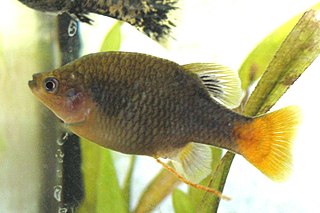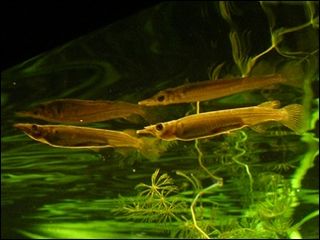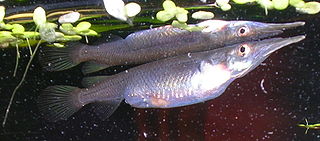
Livebearers are aquarium fish that retain the eggs inside the body and give birth to live, free-swimming young. Among aquarium fish, livebearers are nearly all members of the family Poeciliidae and include guppies, mollies, platies and swordtails.

Goodeidae is a family of teleost fish endemic to Mexico and some areas of the United States. Many species are known as splitfins. This family contains about 50 species within 18 genera. The family is named after ichthyologist George Brown Goode (1851-1896).

The wrestling halfbeak also known as Malayan halfbeak is a species of viviparous halfbeak native to the fresh and brackish waters of rivers and coastal regions in South-East Asia, in Singapore, Thailand, Indonesia, Thailand, Malaysia, Borneo and Sumatra. It is a small, slender, livebearing fish, with the elongated lower jaw characteristic of its family. The colour of this species varies, depending on where the specimen is found. It is the type species of the genus Dermogenys.

The butterfly splitfin or butterfly goodeid, Ameca splendens, is a bony fish from the monotypic genus Ameca of the splitfin family (Goodeidae). It was formerly found throughout the Ameca River drainage in Mexico; the type locality is Rio Teuchitlán in the vicinity of Teuchitlán, Jalisco. The species was only ever found in an area about 10 miles (15 km) in diameter.

Nimbochromis livingstonii, Livingston's cichlid or (locally) kalingono, is a freshwater mouthbrooding cichlid native to Lake Malawi, an African Rift Lake. It is also found in the upper Shire River and Lake Malombe. They are found in inshore areas of the lake over sandy substrates.

The diamond tetra is a small freshwater fish of the characin family of order Characiformes. It is found in and around Lake Valencia in Venezuela, South America.
The striped goodeid, bluetail goodeid or bluetail goodea is an endangered species of fish in the family Goodeidae. Its genus Ataeniobius is monotypic. It is endemic to the Río Verde and associated waters, including the Media Luna and Los Anteojitos lakes, in San Luis Potosí, Mexico. The specific name of this fish honours its discoverer, the America evolutionary biologist William Lawrence Tower (1872–1955) of the University of Chicago.

The nkhomo-benga peacock, also known as the new yellow regal peacock, is a species of haplochromine cichlid which is endemic to Lake Malawi. This species is threatened by capture for the aquarium trade.
The dark-edged splitfin is a species of fish in the family Goodeidae endemic to Mexico. It is a live-bearing, cold-water fish from the mountains of Mexico. The species is incredibly temperature sensitive. If water is too cold, all offspring turn out to be male. If water is too hot, females will birth their first brood of only 1–3 fry and then die shortly thereafter, which makes it very difficult to maintain a colony. It is also a primarily carnivorous species that eats a variety of insects. Girardinichtys multiradiatus is an endangered species with multiple population threats with little conservation efforts put in place to protect the species.
Girardinichthys is a genus of splitfins that are endemic to Mexico. These highly threatened fish are native to the upper Lerma and Balsas basins, as well as water systems in the Valley of Mexico. Through man-made channels G. viviparus has been able to spread to the upper Pánuco River basin. These small fish reach up to 6.5 cm (2.6 in) in length. The name of this genus honours the American herpetologist and ichthyologist Charles Girard (1822-1895).

Goodea is a genus of splitfins that are endemic to Mexico. They are found in a wide range of habitats in several river basins that originate in the Central Plateau, such as Pánuco, Lerma–Chapala–Grande de Santiago and Balsas. Overall this genus is among the most widespread and successful splitfins, although they also have declined and the relatively restricted G. gracilis is considered vulnerable by the IUCN. This genus includes the largests splitfins, reaching a standard length of up to 20 cm (8 in). They are primarily herbivores, but also take small organisms like tiny crustaceans and snails. The is named in honour of the American ichthyologist George Brown Goode (1851-1896).

The Highland splitfin is a species of splitfin endemic to Mexico where it is found in the Lerma River basin. This species grows to a length of 5 centimetres (2.0 in) TL. It is the only known member of its genus, although some authorities have Hubbina as a subgenus of Girardinichthys and add Girardinichthys ireneae to the subgenus, even treating this taxon as a synonym of G. ireneae. This species was described by Don Fernando de Buen y Lozano in 1940 with the type locality given as Cointzio, Michoacán. The name of the genus honours the American ichthyologist Carl Leavitt Hubbs (1894-1979) while the specific name honours Clarence Lester Turner (1890-1969), thus honouring two ichthyologists who worked on a review of the Goodeidae in 1939.

Heterandria formosa is a species of livebearing fish within the family Poeciliidae. This is the same family that includes familiar aquarium fishes such as guppies and mollies. Heterandria formosa is not as commonly kept in aquaria as these species. Despite the common name "least killifish", it belongs to the family Poeciliidae and not to one of the killifish families. H. formosa is one of the smallest fish species; the 1991 Baensch Aquarium Atlas listed it as the 7th smallest fish in the world, and as of 2006 it remains the smallest fish species found in North America.

Xenotoca is a genus of fish in the family Goodeidae from Mexico, where found in a wide range of habitats, from rivers and creeks to pools and lakes, in the Lerma–Grande de Santiago, Panuco, Cuitzeo and other basins of the Mesa Central. While no goodeid is a very common aquarium fish, the redtail splitfin, is one of the most common aquarium goodeids. Its relatively bright colors offset its reputation for being aggressive towards tankmates, occasionally even killing them. Similarly to that species, two species described in 2016 have males with red-orange tails, but this feature is not shared by the remaining members of the genus. The Xenotoca species are small, reaching up to 9 cm (4 in) in standard length.

Nematobrycon palmeri, commonly known as the emperor tetra, is a species of characid fish found in the Atrato and San Juan river basins in western Colombia. It was first imported in the aquarium trade to the United States in 1960 and has since become well established.

Neoheterandria elegans or Tiger Teddy is a small live-bearing fish within the family Poeciliidae. This is the same family that includes familiar aquarium fishes such as guppies and swordtails, although Neoheterandria elegans is not nearly as popular as an aquarium fish. The fish is found in the Truando River in Colombia. Males grow to 2.0 centimetres (0.79 in) and females grow to 2.5 centimetres (0.98 in). The front half of the fish is mostly silver but the rear has alternating gold and black vertical bars.

Zoogoneticus tequila, Tequila splitfin or simply Tequila fish, is a species of goodeid fish from Mexico. The specific epithet, tequila, derives from the Tequila Volcano, which looms near the type locality.

Zenarchopteridae, the viviparous halfbeaks, is a family in the order Beloniformes. The Zenarchopteridae exhibit strong sexual dimorphism, practicing internal fertilisation, and in some cases ovoviviparous or viviparous. The members in the family are mainly found in fresh and brackish water of tropical Asia and New Guinea, but the genus Zenarchopterus also includes marine species from the Indo-Pacific. Several, such as the wrestling halfbeak, have become commonly traded aquarium fish.
Andinoacara stalsbergi is a species of South American freshwater fish in the family Cichlidae. It was previously included in A. rivulatus, but was described as a separate species in 2009. The specific name honours the Norwegian aquarist Alf Stalsberg who collected the type of this species and who has had a “longstanding commitment to increase the knowledge about cichlid fishes”.
Skiffia francesae, the golden skiffia or tiro dorado, is a species of splitfin endemic to the Rio Teuchitlán, a tributary of Río Ameca in western Mexico. It is extinct in the wild, but has been maintained in aquaria and the aquarium hobbyist trade.
















